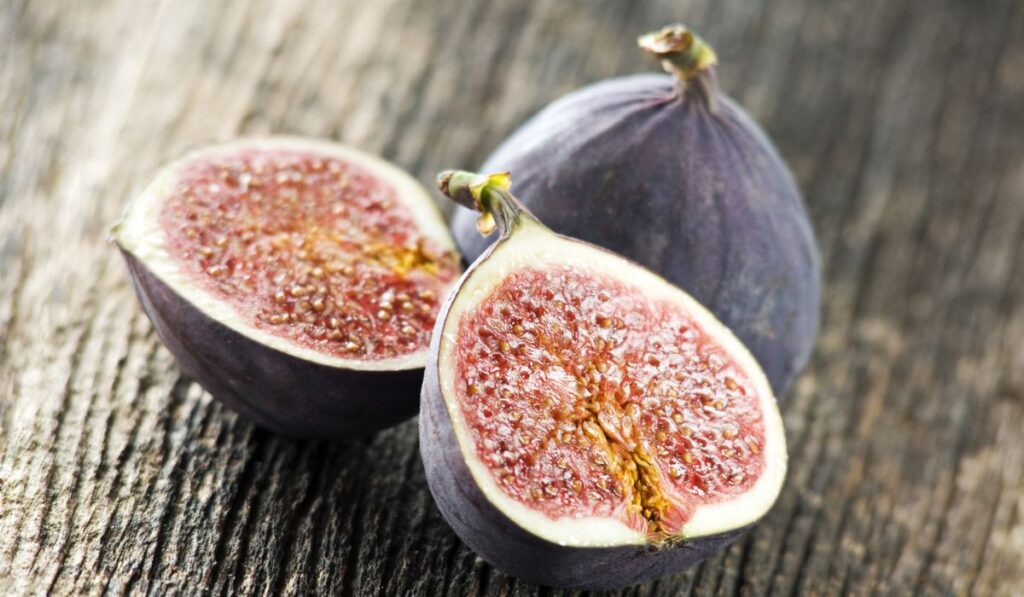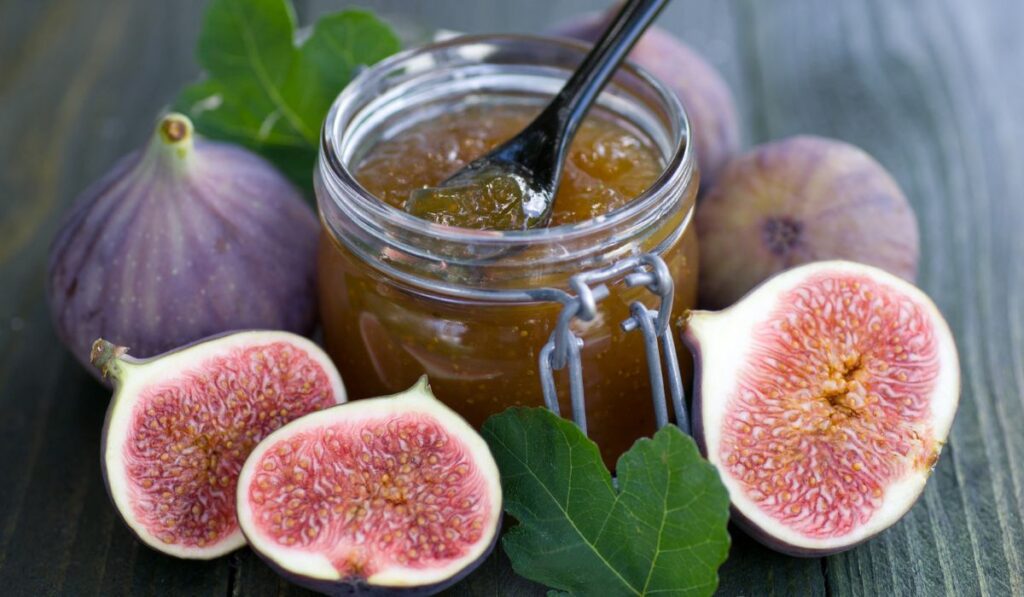Figs are one of the world’s oldest cultivated fruits, known for their berry-like flavor and soft texture. Most figs available worldwide are grown in Portugal, Greece, Spain, Turkey, and America. But when are figs at their best, and where can you find them?
Figs are usually available from May to November, and they can be found in the produce section of some supermarkets. However, fresh figs are very perishable and don’t travel well, so they aren’t found in many stores. Dried and canned figs make great alternatives that are available year-round.
Figs are sweet and versatile fruits that you can use in both desserts and savory dishes — or enjoy raw. Let’s take a look at everything you need to know about figs and how to eat them.
What Are Figs?

Figs are small fruits that can be enjoyed fresh or dried. The fig is native to western Asia and the Mediterranean and is now grown worldwide. A fig plant is typically a small tree with a whitish bark that can grow up to ten meters high.
The fruit is tear-shaped, with a green skin that turns brown or purple as it ripens. Figs have soft, reddish flesh filled with crunchy seeds. These fruits can grow in hot climates and withstand moderately cold temperatures.
Fresh figs are high in nutrients and low calories, making them an excellent addition to your diet.
On the other hand, dried figs are high in sugar and calories because the sugar becomes concentrated once the fruits dry. We therefore recommend the no sugar added dried figs from Nurta Fig (on Amazon).
Figs contain trace amounts of many nutrients, but they are especially high in vitamin B6 and copper. They also contain fiber, which improves digestive health by softening stools, reducing constipation, and acting as a food source for the good bacteria in your stomach.
You can add figs into jams, rolls, biscuits, and other desserts. Because ripe fig fruit is very perishable and doesn’t transport well, most commercial production of these tear-shaped fruits is in processed and dried forms.
If you intend to store figs for longer, you can keep them in the fridge for around a week. Make sure you place them on a shallow plate and ensure they aren’t stacked on top of each other. If you’re lucky, figs can last up to two weeks in the fridge.
Colder temperatures slightly suppress the flavor of figs. Figs also don’t go well with humidity, so it’s best not to cover them.
When’s the Best Time to Buy Figs?
There are typically two fresh fig seasons yearly: the first season is during early summer, and the second season occurs around late summer to early fall. Figs harvested during the second season have thicker skin and are usually sweeter.
The season for figs depends on their variety and location. Generally, black mission figs are the first to appear in the market and are shortly followed by the brown turkey variety.
Furthermore, most green figs are available from June or July. Calimyrna figs have the shortest season of all fig varieties, lasting only three months. Here’s when you can buy the most common fig varieties:
| Variety | Season |
| Black Mission | May – November |
| Brown Turkey | May – November |
| Green Kadota | June – October |
| Sierra | June – November |
| Calimyrna | July – Sept |
You should only buy figs if you intend to use them soon. The reason is that fresh figs spoil within seven to ten days after harvest. This means you only have about three days to use them.
On the other hand, dried figs are available at markets throughout the year.
Why Don’t Stores Sell Fresh Figs?
Figs are highly seasonal and don’t travel well. They ripen quickly after harvest; as a result, preserving them can be a challenge. Aside from that, figs are very soft and easily squashed due to their tenderness.
Figs also don’t ripen much after harvest. Therefore, harvesting them while they’re green with the hope they mature on time isn’t the best strategy. These factors translate to figs being difficult to market, despite their deliciousness.
Dried or canned figs are popular substitutes because fresh figs are very delicate. These substitutes are widely available and reasonably priced in most supermarkets. One of our favorite canned options is Kadota Figs from Roland Foods (on Amazon).
You’ll also be able to keep canned figs in your pantry for up to a year. It’s important to note that you should put dried figs in a sealable plastic bag and refrigerate them after opening.
What’s the Difference Between a Fig and a Date?
While figs and dates have many similarities, they have several differences. They are:
| Feature | Fig | Date |
| Region | Figs are grown in Portugal, Greece, Spain, Turkey, and America. | Dates are native to North Africa and the Middle East but are now grown in tropical regions worldwide. |
| Shape | Figs are round and plump. | Dates are oval and wrinkly; they look like large raisins. |
| Color | Figs are golden yellow or purple. | Dates are deep brown. |
| Seeds | Figs have plenty of small seeds that give them a crunchy texture. | Dates are seedless. |
| Taste | Figs have a berry-like taste. | Dates are significantly sweeter than figs, containing over 30% more sugar and having a caramel-like flavor. |
How Are Figs Typically Eaten?

Figs are a delectable treat to savor. Fresh figs are pretty versatile, complementing meals from salads to pastries. Let’s look at some of the different ways to eat this fruit.
1. Raw
One of the best ways to enjoy figs is by eating them raw in their juiciest form. You can also put them in the fridge for a few minutes to reduce the sweetness.
Moreover, depending on the variety of the figs, you may want to peel the thin outer layer. When eating fresh figs, we recommend being cautious and avoiding eating them with the peels on.
2. With Nuts
Making a salad with figs and nuts is another delicious option. Furthermore, you can add the nuts raw or roast/caramelize them to add a flavorful edge to your salad or sides.
Because figs are sweet and sticky, you can process them in a food processor with nuts to make another delicious snack. Surprisingly, figs also pair well with meat as a condiment or stuffing.
3. With Dessert
Figs are a tasty addition to cakes, rolls, puddings, and any other type of dessert you can think of. Thanks to their softness and sweetness, you can use figs as a sweetener to partially or completely replace sugar. You can also add figs to other traditional desserts, such as baklava.
Furthermore, figs on bread or pizza are worth a try. You can combine cheese and figs on dough or toast. Consider adding some meat to the mix. Doing this makes the meal more filling.
4. With Drinks
Blending figs with soda, ice, and some lemon juice makes for a tasty drink. If you prefer smoother textures, strain the drink before serving.
Furthermore, if you enjoy milkshakes, figs are a great base for them. Blend the fruit, milk, and your preferred serving of vanilla ice cream in a blender. If the blend isn’t sweet enough, adding some honey should do the trick.
5. With Yogurt
Yogurt goes well with almost anything, so it shouldn’t be a surprise that adding figs to yogurt is a delicious combo. You can even add honey for some sweetness and crushed nuts for more texture. Another cereal that figs go with is oats.
Conclusion
Fresh figs are generally in season from late May to early November, with the peak season occurring during fall. However, you can buy dried or canned figs at any time. These sweet fruits contain a decent amount of fiber and are high in calories.
For this reason, it’s best to eat two to three figs per day and consider these rations when adding them to foods or drinks you enjoy.
